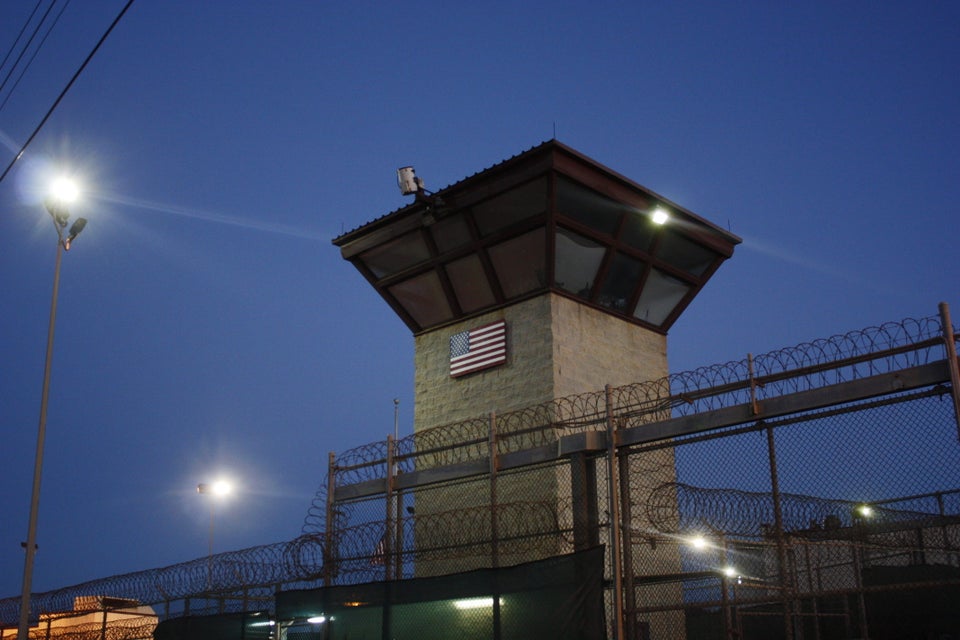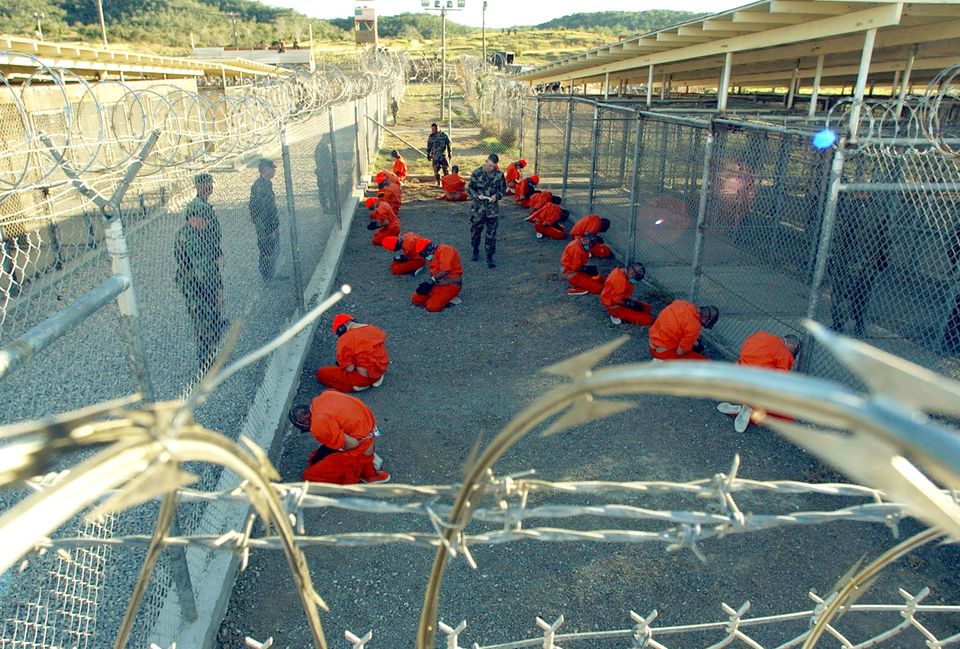WASHINGTON -- The Obama administration said this week that secret videos depicting how the U.S. government treated Guantanamo detainees would make excellent propaganda for Islamic State terrorists. The American public should not be allowed to see the videos, argued the government and military leaders, because of the possibility that they could be used by Islamic extremists or upset people in the Middle East.
Release of the videos would be a threat to national security, one military official claimed, because it would "inflame Muslim sensitivities" and "subject the U.S. Government to criticism."
The videos show military personnel in detention facilities in Guantanamo force-feeding inmates and forcibly extracting them from their cells.
Military officials maintain that the videos do not depict any wrongdoing and only show soldiers, acting as prison guards, behaving in a lawful and humane way. But a lawyer for former Guantanamo detainee Abu Wa-el Dhiab said she had trouble sleeping after seeing videos of her client being force-fed and a Navy nurse refused to engage in the force-feeding process, finding it to be a violation of medial ethics. Dhiab, a 46-year-old from Syria, had been cleared by a variety of intelligence agencies to be transferred from Guantanamo back in 2009, but didn't leave until earlier this year.
The father of four, who is now living with other former Guantanamo inmates in Uruguay, was force-fed because he engaged in a hunger strike in protest of his prolonged detention.
Earlier this month, a federal judge ordered the government to work on redacting the videos in preparation for their public release. A Justice Department lawyer indicated during a hearing that the government would continue fighting for the videos to remain secret and would attempt to demonstrate the "harm that would occur" if they were made public. This week, in a lengthy and heavily redacted filing in federal court, the DOJ made its case for keeping the videos secret.
In the past, the government said, the release of certain "provocative photographs and information has caused harm to national security, including the deaths of U.S. military personnel." The filing cites the release of a video of Marines urinating on corpses of the alleged Taliban members, media reports about burning of Korans and the release of the film "Innocence of Muslims" on YouTube in 2012. (The Obama administration later came under fire for tying the release of that YouTube video to the terrorist attack in Benghazi, Libya, that killed four Americans.)
Even the release of materials "seen as anti-Muslim, without showing perceived mistreatment of individuals, has resulted in violent reaction in the past," Sinclair Harris, a rear admiral in the U.S. Navy, wrote in a declaration. "As an example, release of the film 'Innocence of Muslims' in July 2012 generated 38 protests in a number of cities across Afghanistan, including three that turned violent," he wrote.
Harris concluded that the release of Guantanamo videos "in whole or in part, could reasonably be expected to seriously harm national security." While Harris maintained the videos showed "lawful, humane and appropriate interaction between guards and detainees," he said that "persons and entities hostile to the United States and its detention of enemy belligerents at Guantanamo Bay are likely to think otherwise."
There is "little doubt," Harris wrote, using another name for the Islamic State group, "that ISIL would use imagery from Guantanamo Bay to further encourage its supporters and followers to attack military and government personnel." He mentioned an ISIS video of the beheading of journalist Steven Sotloff, in which Sotloff was made to read a statement about President Obama's promise to close down Guantanamo. Harris also noted that ISIS prisoners are clothed in orange jumpsuits as a reference to Guantanamo detainees. "This demonstrates ISIL's interest in exploiting the Guantanamo detention facility and potentially using Guantanamo detainees in furtherance of its own aims," he wrote. ISIS could "pick and choose what is shared in small bites, without having to address the video honestly."
While the videos show only "standard operating procedures," Harris argued, force-feeding is a "medical procedure not commonly viewed by the general public."
In a separate declaration, Rear Adm. Richard Butler said he was worried that, if videos of forced cell extractions were released, Guantanamo detainees might resist their captors in the future in hopes of having their own videos released. Butler even suggested that Guantanamo detainees, who have been in the custody of the U.S. government for more than a decade, might speak with al-Qaeda or other groups in "coded messages." While the U.S. government itself has previously provided counts of how many Guantanamo detainees were engaged in a hunger strike, releasing the videos would "effectively communicate to the outside world that the detainee is resisting the rules of the detention facility, thus providing another useful propaganda tool for al-Qaeda and its affiliates," Butler argued.
Simultaneously, Butler said that releasing forced cell extraction videos might be inconsistent with the Geneva Conventions because it would show a detainee "in a non-compliant status, and consequently in a potentially unfavorable light." The videos would also damage national security, Butler wrote, simply be "leading some to call into question the United States commitment to upholding the principles of the Geneva Conventions and thus undermine our diplomatic and military relationships with allies and partners abroad."
The videos, he said, could "inflame Muslim sensitivities" and "exacerbate the world's perception of detainees in U.S. custody." In addition, "the release could subject the U.S. Government to criticism that it is inappropriately focusing public attention on one of more detainees," Butler wrote.
In a separate declaration, Rear Adm. Kyle Cozad even wrote that, if the videos were released, he might have to limit detainees' access to media "to prevent their exposure to the videos" or even from "receiving a description of the videos from the media" because the videos "could help them develop strategies for exploitation."
Guantanamo's main detention facilities are viewable on Google Maps, military officials give tours of the facilities to members of the media and photos and videos of the facility are readily available online. But Cozad claimed that the videos could reveal specific details about the physical layout and operations of the detention facility that would "better prepare those hostile to the United States to attack the detention facility, most likely from within."
Cozad's staff "has compared their review of the FCE videos to an NFL team watching video of the previous week's football game to determine what plays worked well, what they did wrong, what what they could do better during the next game," he wrote. If Guantanamo detainees or outsiders could see the videos, they would have a new advantage that could lead to guards being hurt, Cozad argued.
The government argued that there was no First Amendment right for the public to access the videos. Lawyers pointed to a federal court of appeals decision, in which the government argued that releasing photos of Osama bin Laden's body would endanger national security. The appeals court ruled in that case that release of the images "could reasonably be expected to trigger violence and attacks 'against United States interests, personnel, and citizens worldwide'," but noted that they were dealing with "an extraordinary set of images."
The government's arguments this week referenced the previous court decision. In the prior case, the federal appeals court rejected an argument that "the government's declarations show nothing more than that the release of information may cause some individuals who do not like the United States to commit violence overseas, and that courts should not succumb to this kind of blackmail."
The Guantanamo videos could have a similar negative impact abroad, the government argued.
"To be clear, Respondents do not oppose release of the FCE videos merely because release may spur terrorist propaganda, but rather because... any such propaganda is likely to be used by terrorist groups to expand their ranks and to encourage attacks on U.S. personnel, thereby increasing the risk to U.S. personnel overseas, who are often the target of attacks," DOJ argued. "These concerns are not hypothetical, as evidenced by the prior violence that resulted from release of other information."



